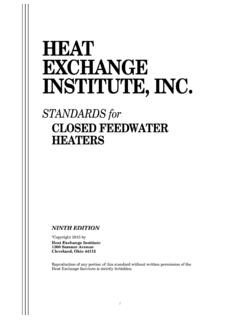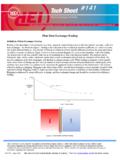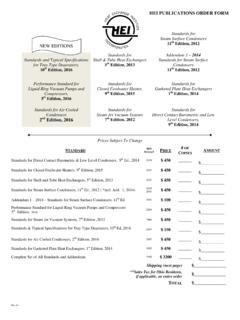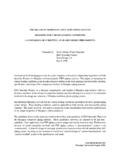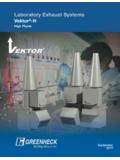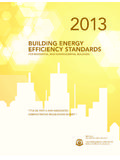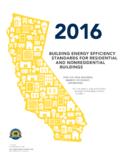Transcription of Vacuum Systems: Understanding A Key ... - Heat …
1 This Tech Sheet was developed by the Heat Exchange Institute s (HEI) Vacuum Technology section . HEI is a trade association comprising the leading manufacturers of heat exchange and Vacuum equipment. HEI Tech Sheets are information tools and should not be used as substitutes for instructions from individual manufacturers. Always consult with individual manufacturers for specific instructions regarding their equipment. 09/25/14 Page 1 of 15 This sheet is reviewed periodically and may be updated. Visit for the latest version. #110 Vacuum Systems: Understanding A Key Component of a Modern Power Plant Introduction Vacuum systems have been used in the power industry for over 100 years. Today, Vacuum equipment, such as liquid ring Vacuum pumps, steam jet ejectors, and hybrid systems, are used for numerous applications in all types of power plants.
2 The proper operation of a power plant s Vacuum system is essential to the proper operation of the entire plant. Plant personnel should have a good working knowledge of the theory and operating principles for Vacuum equipment to assist them in proper operation of their Vacuum systems. Despite the wide variety of applications and types of power plants in which Vacuum equipment is used, the theory and principles of operation are the same for the basic equipment. This article will explore some of the applications and equipment and will provide a thorough Understanding of the theory and operating principles as well as tips for Proper operation and troubleshooting. I. Description of Applications in Power Plants for Vacuum Equipment A.
3 Main Condenser Exhaust Vacuum Equipment Main condenser exhaust Vacuum equipment is designed to continuously remove air and associated water vapor from the main condenser. The operating pressure of the venting equipment is designed per HEI Standards for Steam Surface Condensers, section or HEI Standards for Air Cooled Condensers , section This design pressure is critical for proper operation of the venting equipment and main condenser. Venting equipment capacities are given in HEI Standards for Steam Surface Condensers Table 6, or HEI Standards for Air Cooled Condensers Table 5 as a function of total steam flow into the condenser and the number of exhaust openings. These venting capacities are based on the air vapor mixture at 1 HgA and a vent temperature of F which is F below the saturation temperature corresponding to the main condenser s design pressure of 1" HgA.
4 If the design is required to be other than is specified in HEI standards, the user must include requirements in the specifications. The full range of condenser operating pressures must also be taken into consideration in designing the venting equipment. When ejector systems are used for this purpose it is common to use condensate from the main condenser as cooling medium in the ejector condensers. Liquid ring Vacuum pump systems generally use the same closed cycle cooling water as the main condenser. This Tech Sheet was developed by the Heat Exchange Institute s (HEI) Vacuum Technology section . HEI is a trade association comprising the leading manufacturers of heat exchange and Vacuum equipment. HEI Tech Sheets are information tools and should not be used as substitutes for instructions from individual manufacturers.
5 Always consult with individual manufacturers for specific instructions regarding their equipment. 09/15/14 Page 2 of 15 This sheet is reviewed periodically and may be updated. Visit for the latest version. #110 B. Water Box and Circulated Water Pump Priming Equipment Vacuum equipment is used to prime main condenser cooling water pumps by evacuating the water boxes to a Vacuum level necessary to overcome the difference in head and remove air released from the cooling water during operation. This Vacuum equipment is often also used to remove air pockets from water boxes. Priming valves are often used between water boxes and the Vacuum system to protect the Vacuum system from being flooded with cooling water from the main condenser.
6 It is also common to include a Vacuum reservoir tank to dampen the effects of air surges. C. Steam Side Evacuation Equipment This equipment, often referred to as hoggers, is designed to quickly evacuate the steam side of the main condenser from atmosphere to a low pressure (usually 10" Hg Abs.) in order to allow the turbine to be brought online. The equipment is sized in accordance with the capacities in Table 8 of the HEI Standards for Steam Surface Condensers or in section of the HEI Standards for Air Cooled These capacities are intended to provide an evacuation time of approximately 30 minutes. By their nature, these hoggers are subject to intermittent service. Once evacuation is complete, the hogger is shut down and the main condenser exhauster operates to continuously remove air in-leakage.
7 (1) Suction Pressure - This is determined by the amount of Vacuum required to prime the system and the pressure drops between the hoggers and the system . (2) Capacity - This is determined by the volume of the system and the time allowed to reduce the pressure in the system . Typically, a silencer is used at the discharge of a steam ejector hogger to reduce noise to acceptable levels while the equipment is operating. It is also common practice for liquid ring Vacuum pump systems to use the standby pump in parallel with the main unit to achieve the hogging requirement. Occasionally there may be a separate hogging pump. D. Geothermal The chief consideration in designing Vacuum systems for this application is the large quantity of non-condensible gases contained in geothermal steam for the proper sizing and selection of liquid ring vacuums and steam jet ejectors.
8 The amount and composition of non-condensibles vary from field to field, and must be specifically detailed by the user. When Vacuum pumps are used in this application, solubility of CO2 and other gases must be considered. When steam ejectors are used in this application, design consideration must be given to the presence of non-condensible gases in the motive steam. Furthermore, the corrosive nature of gases in geothermal steam makes material selection a very important aspect of system design. E. Nuclear Nuclear power cycles contain additional non-condensibles such as oxygen and hydrogen as compared to those power cycles where air is the only non-condensible present in the condenser. Oxygen levels of 10-50 ppb over a fairly wide range of operation are to be expected (typical of Boiling Water Reactor (BWR) units).
9 The selection of venting equipment to be used with these types of power systems should be carried out in accordance with HEI Standards for Steam Surface Condensers, section and Table , or HEI Standards for Air Cooled Condensers, section and Table 5 with an allowance for such gases specified. This Tech Sheet was developed by the Heat Exchange Institute s (HEI) Vacuum Technology section . HEI is a trade association comprising the leading manufacturers of heat exchange and Vacuum equipment. HEI Tech Sheets are information tools and should not be used as substitutes for instructions from individual manufacturers. Always consult with individual manufacturers for specific instructions regarding their equipment. 09/15/14 Page 3 of 15 This sheet is reviewed periodically and may be updated.
10 Visit for the latest version. #110 II. Types of Vacuum Equipment Commonly Used A. Steam Jet Ejectors Principle of Operation The Standards for Steam Jet Vacuum Systems states The operating principle of a steam ejector stage is that the pressure energy in the motive steam is converted into velocity energy in the nozzle, and, this high velocity jet of steam entrains the vapor or gas being pumped. The resulting mixture, at the resulting velocity, enters the diffuser where this velocity energy is converted to pressure energy so that the pressure of the mixture at the ejector discharge is substantially higher than the pressure in the suction chamber. An ejector (see sketch below) consists primarily of a body with a suction port, a venturi shaped diffuser tube, and a discharge port.


